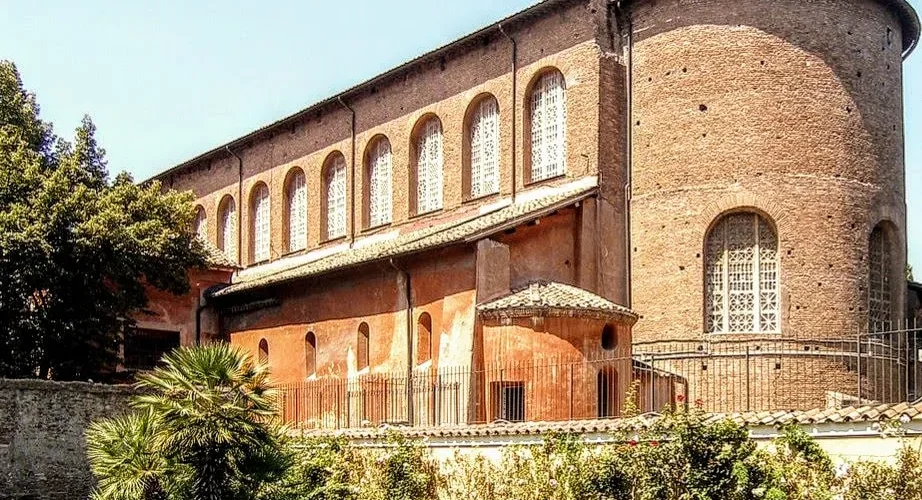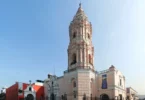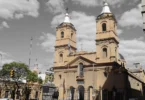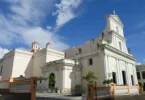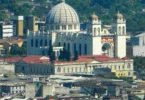Introduction
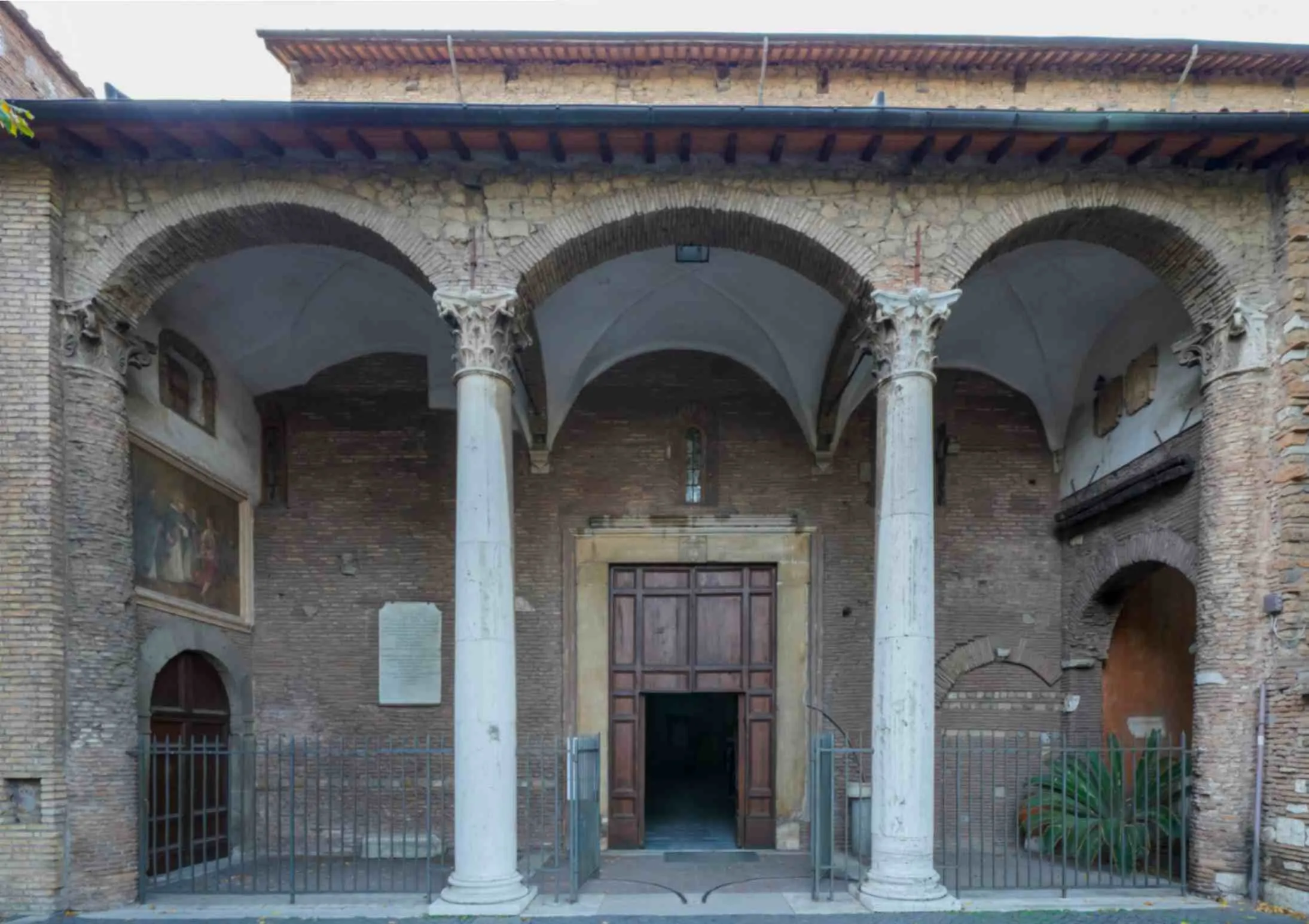
The Basilica of Saint Sabina (Latin: Basilica Sanctae Sabinae, Italian: Basilica di Santa Sabina all’Aventino) is a historic church on the Aventine Hill in Rome, Italy. It is a titular minor basilica and mother church of the Roman Catholic Order of Preachers, better known as the Dominicans.
Santa Sabina is the oldest extant ecclesiastical basilica in Rome that preserves its original colonnaded rectangular plan with apse and architectural style. Its decorations have been restored to their original restrained design. Other basilicas, such as Santa Maria Maggiore, have been ornately decorated in later centuries. Because of its simplicity, the Santa Sabina represents the adaptation of the architecture of the roofed Roman forum or basilica to the basilica churches of Christendom. It is especially well-known for its cypress wood doors carved in AD 430-432 with Biblical scenes, the most famous being the first known publicly displayed depiction of the crucifixion of Jesus Christ and the two thieves.
Santa Sabina is perched high above the Tiber to the north and the Circus Maximus to the east. It is next to the small public park of Giardino degli Aranci (“Garden of Oranges”), which has a scenic terrace overlooking Rome. It is a short distance from Santi Bonifacio ed Alessio and from the headquarters of the Knights of Malta. Its last cardinal priest was Jozef Tomko until his death on 8 August 2022. It is the stational church for Ash Wednesday.
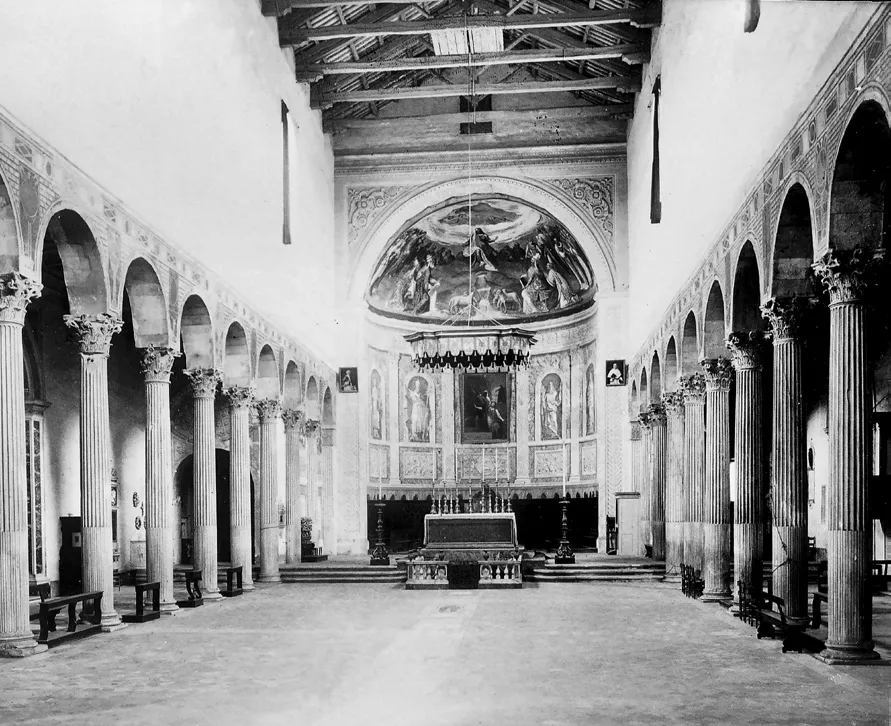
Early History and Foundation of St Nick Sabina
The congregation of St Sabina was based on the site of early Majestic houses, one of which is accepted to have had a place with Sabina, a Roman lady from Avezzano in the Abruzzo locale of Italy. Sabina was executed in Promotion 126 under Head Hadrian since she switched over completely to Christianity through her worker Serapia, who was likewise martyred in Advertisement 119. Both Sabina and Serapia were subsequently pronounced Catholic holy people.
Development of the congregation started somewhere in the range of 422 and 432 Promotion, dispatched by Peter of Illyria, a Dalmatian minister. The congregation was worked close to a sanctuary devoted to Juno on Aventine Slope in Rome. In 423 Promotion, Pope Celestine I laid out the cardinal title of St Nick Sabina, making it a significant site in the Congregation. During the ninth hundred years, the congregation was encased inside an invigorated region for insurance because of continuous conflicts.
In 1216, Pope Honorius III endorsed the production of the Request for Evangelists, otherwise called the Dominican Request, which was the primary strict request in the Congregation with a scholarly mission. Holy person Dominic, the organizer behind the request, was welcomed by Pope Honorius III to take home at St Nick Sabina in 1220. The authority underpinning of the Dominican religious circle at St Nick Sabina occurred on 5 June 1222, with the legitimate exchange of property to the Request.
St Sabina was likewise the site of an ecclesiastical meeting in 1287, albeit the gathering was interfered with when a pestilence killed six prelates. The cardinals got back to the congregation and chose Nicholas IV as pope on 22 February 1288.
The inside of the congregation was revamped in 1587 by Domenico Fontana, charged by Pope Sixtus V, and further remodeled in 1643 by Francesco Borromini.
In 1870, following the success of Rome by the Realm of Italy, the Dominicans were removed, and the congregation was changed over into a lazaretto (a quarantine station for oceanic voyagers). In the mid twentieth hundred years, Antonio Muñoz reestablished the congregation’s unique archaic appearance from 1914 to 1919, and P. Berthier finished extra reclamation work somewhere in the range of 1936 and 1938. Prominent figures who lived in the adjoining religious circle incorporate Holy person Dominic (1220-1221), St. Thomas Aquinas (1265-1268), Favored Ceslaus, Holy person Hyacinth, and Pope Pius V.
Architecture of the Basilica of Santa Sabina, Rome, Italy
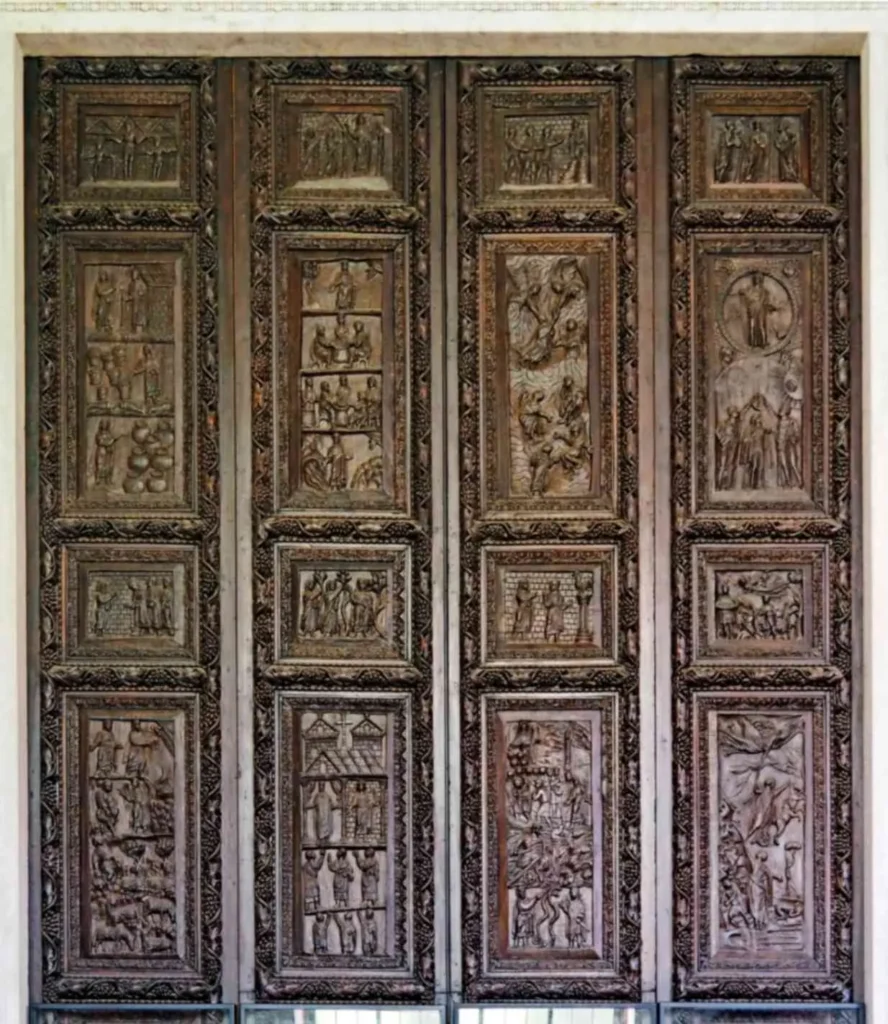
Exterior of Santa Sabina
The Minor Basilica of Santa Sabina is designed in the style of an Ancient Roman secular basilica, resembling a covered forum. Its architectural features include a long central nave with lower aisles on each side. The nave walls are pierced by large clerestory windows that allow natural light to flood the interior. The brick walls are largely unrendered, maintaining the original appearance of the structure as it would have appeared in the 5th century. The windows are made of selenite, rather than glass, preserving the ancient look of the basilica.
The church has a colonnaded porch opening to a cloister, and at the opposite end, a semi-circular apse completes the building’s layout. The campanile (bell tower) was originally constructed in the 10th century, but it was rebuilt in the 17th century in the Baroque style, which is typical of the period.
The wooden door of the basilica is believed to be the original from 430-432 AD, though it was not specifically made for this doorway. Eighteen panels of the door have survived, many of which depict scenes from the Bible. Notably, one panel features one of the earliest known depictions of the crucifixion of Jesus Christ alongside the two thieves. These panels have been studied extensively for their significance in Christian iconography. Above the doorway, an original Latin dedication in hexameters is preserved, further solidifying the basilica’s ancient origins.
Interior of Santa Sabina
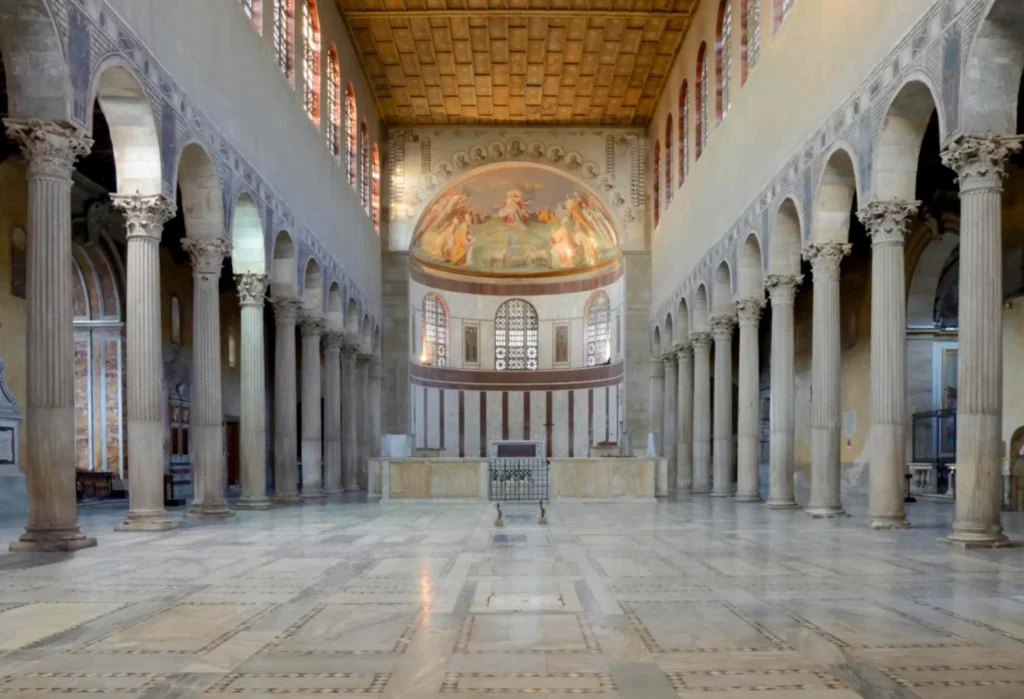
The interior of Santa Sabina follows the traditional basilical form, with a central nave separated from the side aisles by two rows of columns that support an arcade. Above the arcade is another row of large clerestory windows, allowing for an abundance of light within the church. The twenty-four columns are made of Proconnesian marble and feature perfectly matched Corinthian capitals and bases, which were originally reused from the Temple of Juno.
A framed hole in the floor reveals a Roman-era temple column, likely the remains of the Temple of Juno that once stood on the hilltop site before the basilica was constructed. This column is a physical connection to the site’s ancient past.
At the eastern end of the church is the apse, originally adorned with a 5th-century mosaic. However, in 1559, this mosaic was replaced by a fresco by Taddeo Zuccari. The fresco composition likely mirrored the original, featuring Christ flanked by the good thief and the bad thief, seated on a hill while lambs drink from a stream at the base. This iconography bears similarities to another 5th-century mosaic, which was destroyed in the 17th century, located in Sant’Andrea in Catabarbara.
The Dominican Convent
The interior cells of the Dominican convent at Santa Sabina have changed little since the early days of the Order of Preachers. The cell of St. Dominic is still identified, though it has been enlarged and converted into a chapel over time. Additionally, the original dining room remains intact, and it is said that St. Thomas Aquinas dined there when he lived in Rome. The convent retains a sense of its historical significance, providing a direct connection to the Dominican heritage of the site. The Doors of Santa Sabina
The doors of Santa Sabina are crafted from cypress wood and originally featured twenty-eight panels, although ten have been lost over time. Of the remaining panels, most depict scenes from the Old and New Testaments, with one panel near the bottom featuring an homage to a man wearing a chlamys, possibly representing a powerful ruler, though the exact story remains unknown. A particularly famous panel near the top shows one of the earliest known depictions of the crucifixion of Christ, framed by a structure resembling a Roman mausoleum. This door is notable for its distinctive blend of classical and simplified carving styles, suggesting that multiple artists contributed to its design. Additionally, the vegetal designs on the frame align with Mesopotamian influences, pointing to a possible Eastern origin for at least one of the artists. The door may have originally been constructed for a larger building, as it appears to have been cut down to fit Santa Sabina’s doorway. Dendrochronological and radiocarbon dating of the wood confirm that the panels date to the early 5th century, aligning with the time of the church’s construction around 432 AD, under the reign of Emperor Theodosius II.
The Dominican Order at Santa Sabina
In 1216, Pope Honorius III approved the establishment of the Order of Preachers (Dominicans), marking the first academic religious order in the Church. Saint Dominic moved to Santa Sabina in 1220, and in 1222, the pope officially transferred ownership of the church to the Dominicans, establishing it as their headquarters in Rome. In 1265, Thomas Aquinas was appointed as regent master of the studium conventuale at Santa Sabina, transforming it into the first Dominican studium provinciale, a school for the Order’s province. The studium became a major center for the study of philosophy, covering moral and natural philosophy, which played a pivotal role in Dominican education. After Aquinas’ departure in 1268, the theological focus of the studium was moved to Santa Maria sopra Minerva in 1288, while Santa Sabina became dedicated to advanced studies in logic, particularly Aristotelian philosophy. The studium continued to evolve, and by the 14th century, it had become a significant hub for logic and philosophy, with scholars like Milone da Velletri and Giovanni Zocco da Spoleto contributing to its academic legacy.
Feast Day
Feast Day: 29th August
The feast day of the Basilica of Santa Sabina in Rome is celebrated on August 29. This date honors the beheading of Saint John the Baptist, which is the liturgical feast of the Beheading of St. John the Baptist in the Christian calendar. Santa Sabina itself is an important historical and religious site, and while the feast day is tied to St. John the Baptist, the basilica’s long history as a center for the Dominican Order makes it an important venue for religious observance as well.
Church Mass Timing
Monday : 7:30 am
Tuesday : 7:30 am
Wednesday : 7:30 am
Thursday : 7:30 am
Friday : 7:30 am
Saturday : 7:30 am
Sunday : 8:00 am, 11:30am
Church Opening Time:
Monday : 12:00 pm –7:00 pm
Tuesday : 8:00 am –7:00 pm
Wednesday : 8:00 am –7:00 pm
Thursday : 8:00 am –7:00 pm
Friday : 8:00 am –7:00 pm
Saturday : 8:00 am –7:00 pm
Sunday : 12:00 pm –7:00 pm
Contact Info
Address :
Piazza Pietro D’Illiria, 1, 00153 Roma RM, Italy
Phone : +3906579401
Accommodations
Connectivities
Airway
Rome Airport (FCO) to Basilica of Santa Sabina, Rome, Italy distance between 35 min (26.8 km) via A91.
Railway
Aventino/Albania to basilica of santa sabina rome italy distance between 2 min (700.0 m) via Via di Santa Prisca and V. Sant’Alberto Magno.

